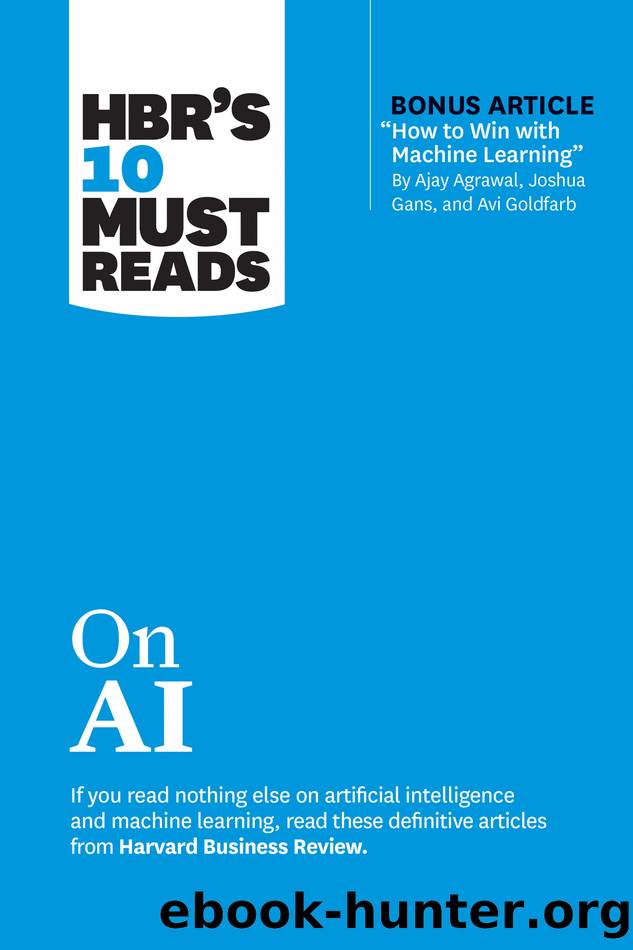HBRâs 10 Must Reads on AI (with bonus article âHow to Win with Machine Learningâ by Ajay Agrawal, Joshua Gans, and Avi Goldfarb) by Harvard Business Review

Author:Harvard Business Review
Language: eng
Format: epub
Publisher: Harvard Business Review Press
Published: 2023-09-05T00:00:00+00:00
The Psychological Impact of Algorithmic Pricing
Letâs start with the case of Root Insurance, which sells auto policies in 30 U.S. states. To better educate and foster relationships with its customers, the company devised a dynamic pricing program that treats each driver in a personal and transparent manner. Unlike its competitors, Root doesnât segment pricing using large, relatively anonymous risk pools generated from demographic data. Instead, it offers drivers a smartphone app that measures their day-to-day behavior behind the wheel. This data gets fed into an algorithm to calculate individual safety scores. Root then bases insurance premiums primarily on how well drivers perform, while giving some weight to traditional factors such as credit scores and insurance fraud statistics. To reduce bias against under-resourced customers, Root avoids considering anyoneâs education or occupation (other common industry factors), and it has committed to dropping credit scores from its rates by 2025. The company also insures only those people who pass its safety test. By weeding out bad drivers, Root claims it can reduce the expenses associated with accidents and lower the price of insurance for all its customers.
Rootâs model is an effective example of how pricing algorithmsâand transparency about themâcan improve customer relationships. First, before a customer ever sees the price of a Root policy, she knows what the company does and doesnât take into consideration. Second, the customer knows why she was offered a specific price that differs from what someone else might pay. Third, she knows what Root did on her behalf to minimize the final cost of insurance.
Making customers understand the mutually beneficial nature of algorithmic pricing is key to its success. Thatâs because overpaying for something can be painfulâliterally. Research conducted by neuroscientists at Carnegie Mellon, Stanford, and MIT has shown that pain centers in the human brain are activated when people see a product with an excessive price tag.
The mere act of asking for moneyâregardless of when or howâinstantly shifts the focus of the customer relationship from pursuing aligned interests to reconciling opposing interests. In the worst cases, asking for money can be alienating to customers. The challenge for the customer-centric organization is to minimize the risks and limit the damage that occurs when market norms drive price increases and intrude upon an otherwise well-nurtured relationship.
Before pricing algorithms became widely used, prices were stickier and differed little from one seller to another. Customers had relatively stable expectations and did not perceive prices as personal. Whenever price changes created discrepancies between actual and expected cost, it was easier for customers to rationalize the increases, believing that they were being implemented universally as part of a carefully crafted corporate strategy.
Technology has made the clashes more frequent, more arbitrary-seeming, and more startling in sizeâwhich unsettles customers and makes it harder than ever for them to reconcile what they see with what they expect. At the same time, many firms have come to believe that whenever customersâ price expectations are stable and disruptions are minimal, the company must be leaving too much money on the table.
Download
This site does not store any files on its server. We only index and link to content provided by other sites. Please contact the content providers to delete copyright contents if any and email us, we'll remove relevant links or contents immediately.
What's Done in Darkness by Kayla Perrin(26779)
The Ultimate Python Exercise Book: 700 Practical Exercises for Beginners with Quiz Questions by Copy(20639)
De Souza H. Master the Age of Artificial Intelligences. The Basic Guide...2024 by Unknown(20430)
D:\Jan\FTP\HOL\Work\Alien Breed - Tower Assault CD32 Alien Breed II - The Horror Continues Manual 1.jpg by PDFCreator(20412)
The Fifty Shades Trilogy & Grey by E L James(19249)
Shot Through the Heart: DI Grace Fisher 2 by Isabelle Grey(19233)
Shot Through the Heart by Mercy Celeste(19093)
Wolf & Parchment: New Theory Spice & Wolf, Vol. 10 by Isuna Hasekura and Jyuu Ayakura(17270)
Python GUI Applications using PyQt5 : The hands-on guide to build apps with Python by Verdugo Leire(17214)
Peren F. Statistics for Business and Economics...Essential Formulas 3ed 2025 by Unknown(17056)
Wolf & Parchment: New Theory Spice & Wolf, Vol. 03 by Isuna Hasekura and Jyuu Ayakura & Jyuu Ayakura(16973)
Wolf & Parchment: New Theory Spice & Wolf, Vol. 01 by Isuna Hasekura and Jyuu Ayakura & Jyuu Ayakura(16602)
The Subtle Art of Not Giving a F*ck by Mark Manson(14571)
The 3rd Cycle of the Betrayed Series Collection: Extremely Controversial Historical Thrillers (Betrayed Series Boxed set) by McCray Carolyn(14294)
Stepbrother Stories 2 - 21 Taboo Story Collection (Brother Sister Stepbrother Stepsister Taboo Pseudo Incest Family Virgin Creampie Pregnant Forced Pregnancy Breeding) by Roxi Harding(13945)
Scorched Earth by Nick Kyme(12934)
Drei Generationen auf dem Jakobsweg by Stein Pia(11129)
Suna by Ziefle Pia(11052)
Scythe by Neal Shusterman(10519)
